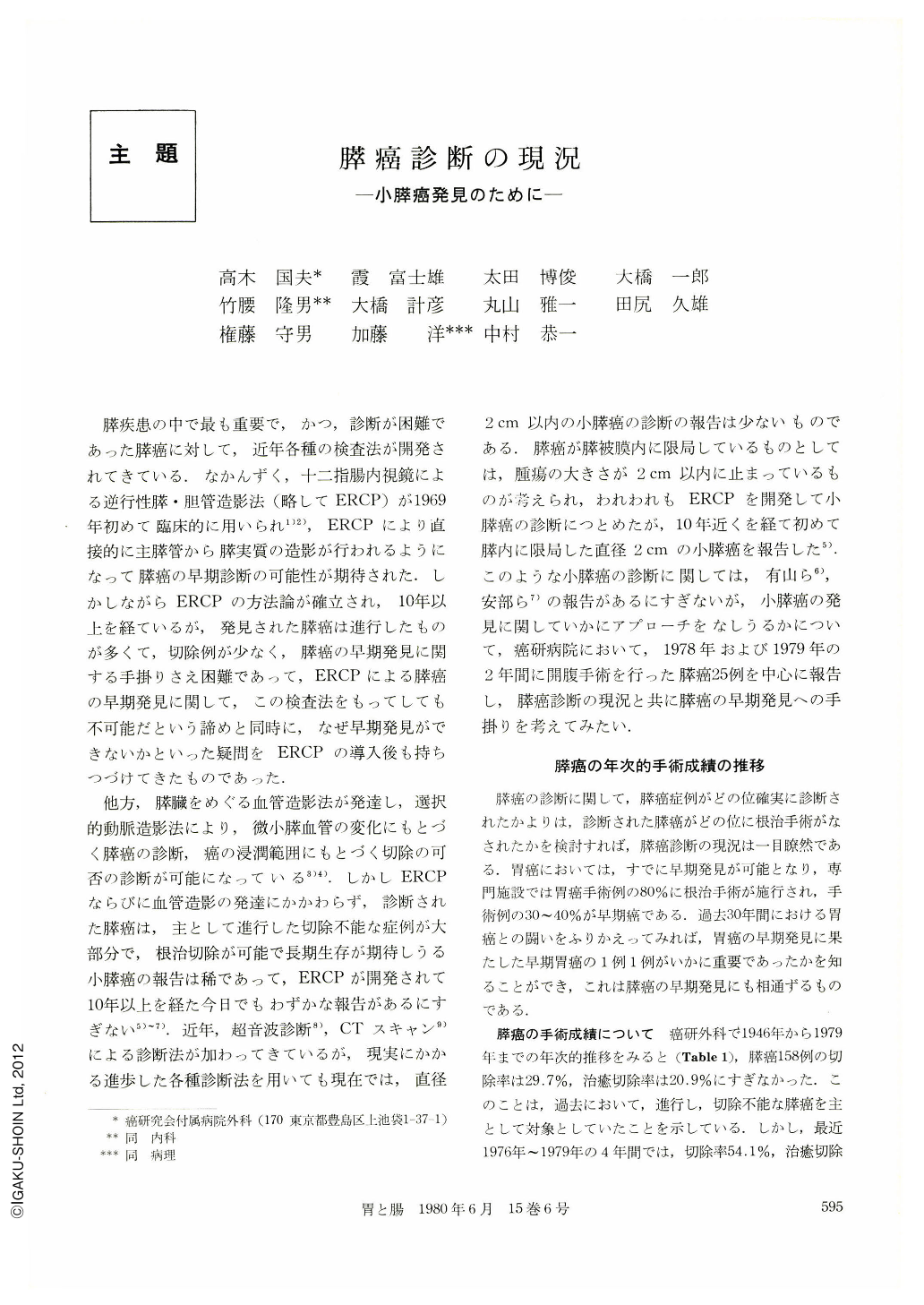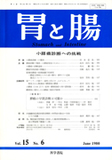Japanese
English
- 有料閲覧
- Abstract 文献概要
- 1ページ目 Look Inside
膵疾患の中で最も重要で,かつ,診断が困難であった膵癌に対して,近年各種の検査法が開発されてきている.なかんずく,十二指腸内視鏡による逆行性膵・胆管造影法(略してERCP)が1969年初めて臨床的に用いられ1)2),ERCPにより直接的に主膵管から膵実質の造影が行われるようになって膵癌の早期診断の可能性が期待された.しかしながらERCPの方法論が確立され,10年以上を経ているが,発見された膵癌は進行したものが多くて,切除例が少なく,膵癌の早期発見に関する手掛りさえ困難であって,ERCPによる膵癌の早期発見に関して,この検査法をもってしても不可能だという諦めと同時に,なぜ早期発見ができないかといった疑問をERCPの導入後も持ちつづけてきたものであった.
他方,膵臓をめぐる血管造影法が発達し,選択的動脈造影法により,微小膵血管の変化にもとつく膵癌の診断,癌の浸潤範囲にもとつく切除の可否の診断が可能になっている3)4).しかしERCPならびに血管造影の発達にかかわらず,診断された膵癌は,主として進行した切除不能な症例が大部分で,根治切除が可能で長期生存が期待しうる小膵癌の報告は稀であって,ERCPが開発されて10年以上を経た今日でもわずかな報告があるにすぎない5)~7).近年,超音波診断8),CTスキャン9)による診断法が加わってきているが,現実にかかる進歩した各種診断法を用いても現在では,直径2cm以内の小膵癌の診断の報告は少ないものである.膵癌が膵被膜内に限局しているものとしては,腫瘍の大きさが2cm以内に止まっているものが考えられ,われわれもERCPを開発して小膵癌の診断につとめたが,10年近くを経て初めて膵内に限局した直径2cmの小膵癌を報告した5).このような小膵癌の診断に関しては,有山ら6),安部ら7)の報告があるにすぎないが,小膵癌の発見に関していかにアプローチをなしうるかについて,癌研病院において,1978年および1979年の2年間に開腹手術を行った膵癌25例を中心に報告し,膵癌診断の現況と共に膵癌の早期発見への手掛りを考えてみたい.
Progress in various diagnostic procedures of pancreatic diseases has made it possible to diagnose relatively easily cancer of the pancreas hitherto diflicult to confirm as such. In fact, ERCP and angiography could reveal pancreatic cancer less than 2 cm in diameter. However, this possibility is not directly linked up at present with the discovery of small cancer of this organ. In other words, screening methods which leadings to through examination with the use of ERCP and angiography are of great importance in attaining the detection of pancreatic abnormality. For this purpose, we have studied 25 cases of pancreatic cancer encountered during the two years 1978~1979. The re-sectability hitherto published ranged from 10 to 20 per cent and the subjects were all of advanced carcinoma. In our hospital as well, the resectability was 20 per cent in the year from 1946 to 1977. In the last two year (1978~1979), we were able to resect 14 out of 25 cases of pancreatic carcinoma. Thus, the resectability became as high as 56 per cent. This increase is due to the following fact: we were able to detect two cases of small cancer measuring 2cm in diameter; in three cases we actively resected the portal vein; and we organized groups of doctors for the detection of cancer of the pancreas and choleclochus, especially close tie-up of internists and surgeons for diagnosis and treatment. We were also engaged in daily consutation, always bearing in mind how to detect pancreatic cancer.
The clues that led to the diagnosis of pancreatic cancer in 25 cases encounted for the last 2 years were jaundice in 6 cases, displacement of the stomach found in examination in 6, ERCP in 6, upper GI series in 4, elevation of serum and urinary amylase level in 2 and 1 each of ultrasonic examination and laparotomy. In cancer of the tail of the pancreas, displacement of the stomach by external factors was seen in 6 out of 8 cases during the examination of the stomach. Suspicion of cancer was confirmed in all cases as such by ERCP. Displacement of the stomach by pancreatic cancer is usually seen on both the lesser and greater curvatures of the body, but it is often overlooked. This finding is especially important in detecting cancer of the body of the pancreas because it is believed so diflicult to diagnose.
Of two Cases (Case 2 and 25) in which elevated levels of urinary and serum amylase led to the correct diagnosis, Case 2 was cancer of the head of the pancreas measuring 2 cm in diameter. The chief complaint was pain in the upper abdomen, and transitory elevation of urinary amylase level gave us a clue to possible presence of cancer, and ERCP revealed narrowing of the pancreatic duct. Curative resection was thus possible. This experience led us to detection of another case of cancer (Case 25) as we checked the level of urinary and serum amylase level in patients complaining of pain in the upper abdomen. Curative resection cancer of the head of the pancreas. was done in this patient. In both cases jaundice was not seen. Elevated level of urinary and serum amylase level was caused by the narrowing of the main duct in an early stage of pancreatic cancer. Not only this fact but also dilatation of the main duct distal to the narrowing and appearance of accompanying pancreatitis should be suspected by checking the level of urinary and serum amylase level and taking into account symptoms in the upper abdomen. ERCP should be done at the first check for the detection of any lesion in the pancreas. Discussion and study on accurate diagnosis and resectability further made possible by angiography can, we believe, lead to early discovery of pancreatic cancer.
This study was supported by the grant of Japan IBM Co.

Copyright © 1980, Igaku-Shoin Ltd. All rights reserved.


